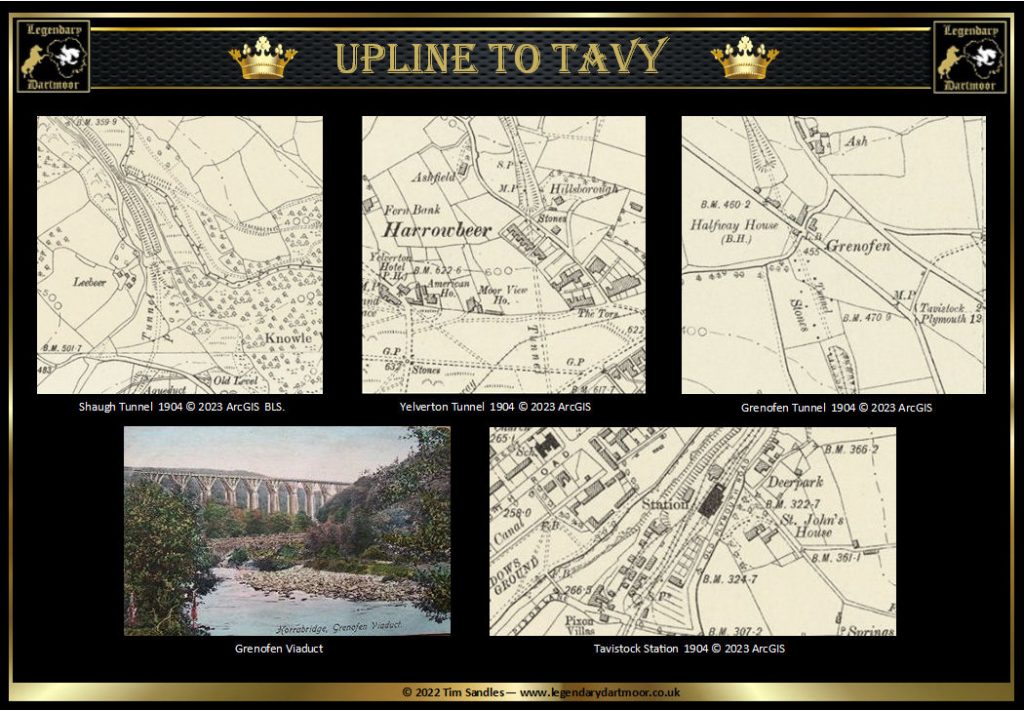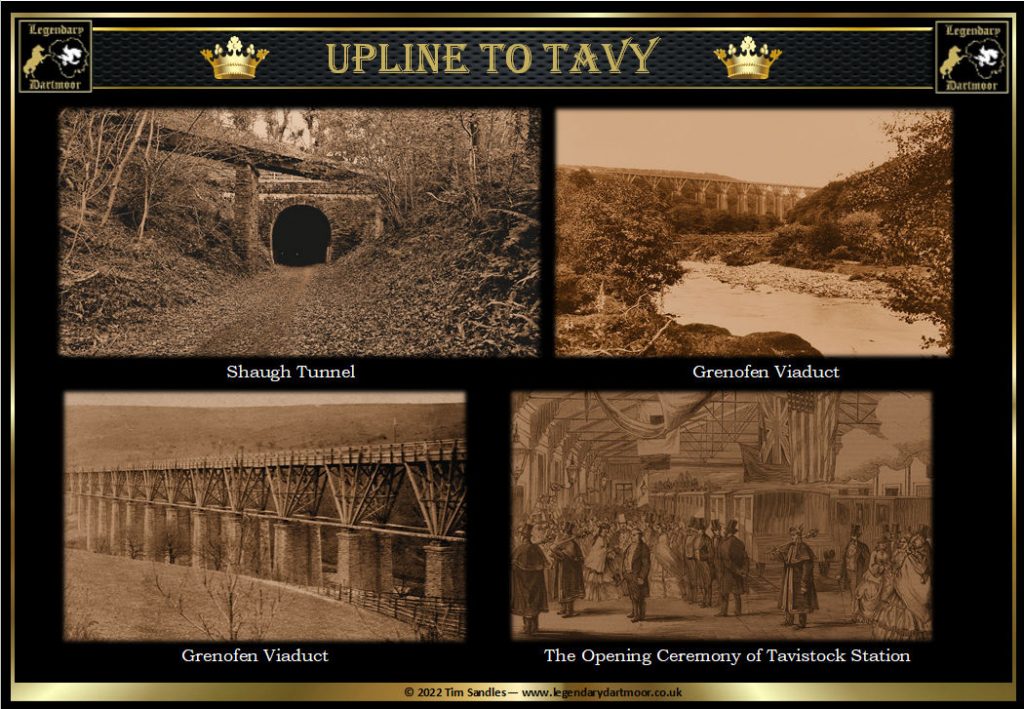
On the 24th of September 1856, a large party of the great and good met at Roborough Rock for an auspicious occasion. They had gathered there to witness the cutting of the first sod of earth for what was to be the South Devon Plymouth to Tavistock railway line. Amongst the VIPs was Mr. John Kelly, the mayor of Plymouth, Mr. Dabb, the deputy-chairman of the line, two directors, Mr. W. E. Rendle and Mr. Frean, and Mr. Bampton the engineer. About two o’clock Mrs Rendle cut the first sod and placed it in a wheelbarrow. Other ladies did similar until the barrow was filled and the mayor wheeled it away. Champagne toasts of “success to the railway” were made and the company then retired to the Rock Hotel for a meal along with numerous other toasts and speeches. Unfortunately Mr. Bampton died a few months after this ceremony and was replaced by Isambard Kingdom Brunel.
On Friday the 3rd of December 1858 work on the line had progressed at a pace and on that day a reporter was invited to inspect the work. This account of his describes his experience on the Dartmoor section of the line. “Having arrived at Shaugh tunnel, (aka Smokey’s Tunnel) we find that there is some rough ground to traverse. Large overcoats and caps are offered to us, and with a candle surrounded by a piece of clay for the hand, we fancy we are about to descend into the depths of a Cornish mine. We enter into the blackest of darkness – into a darkness that may be felt, where all that marks our friends, and the engineer who gives us a helping hand, is the misty glimmer that accompanies them. Our road lies through slush and mire, but it is a busy scene. At the mouth of the tunnel scores of men are busy working away at the roof, facing it with granite. Further on we come across horses drawing out lodes of stones, and still further there are men preparing to blast the rock, which is everywhere so hard as to be only removable by that process. On the day we passed through the tunnel the weather was damp, and no air was stirring, so that the men were working in the fumes of gunpowder. There was only room at the north end to scramble over the rocks through a small opening, after which we soon emerged into the open light of day. The change was extremely agreeable, and a bounteous draught of sherry, quaffed out of a silver tankard, and accompanied with a delicious sandwich, gratified the appetite, and restored nature to its proper tone. It was worth going through that tunnel to get such an appetite when there were immediate means for appeasing it.
The tunnel is 308 yards long and is cut principally through granite. The work is much harder than expected, for the granite was intersected with veins of spar, and is most difficult to work. There is one shaft near the centre of the tunnel. All the tunnels are for a single line, as are all the other works excepting the over bridges which are formed to allow of a double line being made if the traffic should ever be of such a character as to require it, after emerging from this tunnel we walked up to the site of the shaft in order to get a view of the opposite hills. There is a fine view of the valleys of the Cad and the Meavy, and round the base of one of the hills to the Dewerstone there is a tramway in course of construction to some granite quarries, belonging to the Hay Tor Company. It is probable that this tramway will join the Tavistock line shortly after the opening. It is being constructed by Mr. D. G. Grose, who under Mr. Brunel, the consulting engineer, has charge of the first seven and a half miles of the Tavistock line, which the writer has just traversed, and which is very heavy work.
From the tunnel we pass over a long embankment to a point about six miles from the junction; from thence to Yelverton tunnel the line is completed, the timber being laid for the rails. A deep cutting at the south end leads to this tunnel. The tunnel is 650 yards in length and is quite finished. The stratum here is slate. It was commenced in September 1856, and was the point where the turf was first cut, during the mayoralty of John Kelly, Esq. It was worked from four shafts, with comparative ease. Some veins of ore were discovered crossing it in different places. On coming out of the tunnel there is an embankment 40 feet in height, which is not quite finished. The works are pretty far advanced between this and the point where the line crosses the Plymouth and Tavistock turnpike road near Horrabridge. It then curves round to the western side of the turnpike road, till it crosses it again near Grenofen. At Horrabridge a station will be erected nearly opposite the Roborough Inn. About five furlongs from the station is the Magpie viaduct, having four openings. This is about 70 feet high. The next heavy work is the Walkhampton viaduct, which stretching as it does, across the valley, is a striking object from the turnpike road. It is stupendous work, being above a thousand feet long and 136 feet high. The whole line, from the extreme beauty of the scenery, as well as the engineering difficulties which have had to be surmounted, will leave lasting impression on the cockney visitors when they come to traverse it.
Shortly after passing this viaduct, we come to the Grenofen tunnel, which is 360 yards long. About 100 yards of this still requires not be completed with its masonry. This tunnel has been made with considerable difficulty, in consequence of the softness of the ground requiring a great quantity of timber to be used before the masonry can be constructed. The ground is very heavy, and by its softness, contrasts greatly with the general character of the country through which the other parts of the line has passed, the other strata being generally of a very hard character. From Grenofen tunnel to Tavistock, which is two miles, is very lightwork and ready to receive the permanent way.
The Tavistock station will be on the eastern side of the river Tavy, abutting on the river, and facing the monastic walk at the back of the Bedford Hotel, near the abbey bridge. Near the walls that bound the river, there is a large embankment, which has been raised, and the works of the station have commenced. The platform walls are already built, and the station will be a handsome and very commodious one, with accommodation for first and other class passengers, and all the offices necessary for commercial traffic. The station is placed in a position that will allow of a line going north or in any other direction that the public convenience may require. Mr. Glennie has charge of the remainder of the line from the point at which Mr. Grose leaves off, and it is expected that the whole of the works will be ready for opening in March next.”
– The Tavistock Gazette, December 3rd, 1858.
Despite the optimistic estimation the Plymouth to Tavistock line was never officially opened until the 21st of June 1859. The first train left Plymouth at half past one with between three and four hundred passengers aboard. On arrival at Tavistock the train was met by the portreeve who read an address to the assembled gathering. Following this there was a grand parade through the town which was festooned with decorations and triumphal arches. Later that day a “dejeuner” was provided by the portreeve for some 120 guests at the Bedford Hotel. The day concluded with a spectacular firework display. Here is a brief description from a passenger on that inaugural train – “No line of railway in the country of double the length is so rich in its attractive features. Its point of junction with the South Devon Railway is about three miles from Plymouth, whence it traverses the beautiful vale of the Plym, and – alternately winding along the sides of the hills, and by the friendly aid of an occasional viaduct leaping, at a bound, across deep valleys and murmuring rivulets – many an attractive woodland scene, diversified with threes of every growth, was presented to the eye as the train pursued its hurried course, whilst here and there were seen a village church perched upon a distant hill, or sheltered by a clump of trees, an humble cottage, with its smoke-wreath dispersing and losing itself as it gained the summit of the glen, all contributing to form a succession of pictures not easily to be forgotten.”
 Legendary Dartmoor The many aspects past and present of Dartmoor
Legendary Dartmoor The many aspects past and present of Dartmoor


